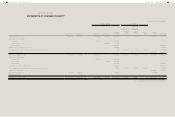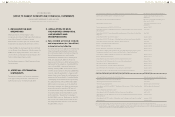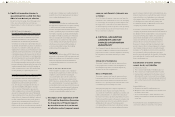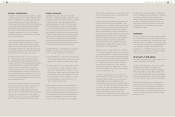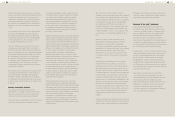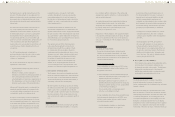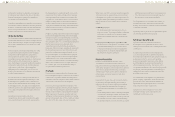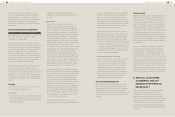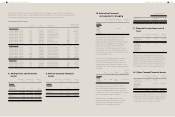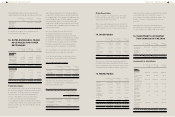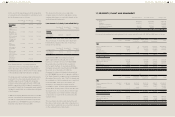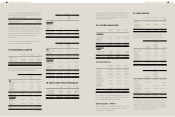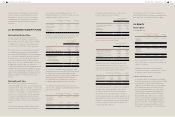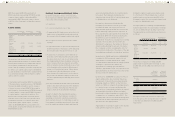HTC 2013 Annual Report Download - page 99
Download and view the complete annual report
Please find page 99 of the 2013 HTC annual report below. You can navigate through the pages in the report by either clicking on the pages listed below, or by using the keyword search tool below to find specific information within the annual report.
FINANCIAL INFORMATION FINANCIAL INFORMATION
194 195
For financial assets carried at amortized cost, the
amount of the impairment loss recognized is the
difference between the asset's carrying amount and
the present value of estimated future cash flows,
discounted at the financial asset's original effective
interest rate.
For financial assets measured at amortized cost,
if, in a subsequent period, the amount of the
impairment loss decreases and the decrease can
be related objectively to an event occurring after
the impairment was recognized, the previously
recognized impairment loss is reversed through
profit or loss to the extent that the carrying amount
of the investment at the date the impairment is
reversed does not exceed what the amortized cost
would have been had the impairment not been
recognized.
For AFS equity investments, a significant or
prolonged decline in the fair value of the security
below its cost is considered to be objective
evidence of impairment.
For all other financial assets, objective evidence of
impairment could include:
‧ Significant financial difficulty of the issuer or
counterparty; or
‧ Breach of contract, such as a default or
delinquency in interest or principal payments; or
‧ It becoming probable that the borrower will
enter bankruptcy or financial re-organization; or
‧ The disappearance of an active market for that
financial asset because of financial difficulties.
When an AFS financial asset is considered to be
impaired, cumulative gains or losses previously
recognized in other comprehensive income are
reclassified to profit or loss in the period.
In respect of AFS equity securities, impairment
losses previously recognized in profit or loss are
not reversed through profit or loss. Any increase
in fair value subsequent to an impairment loss is
recognized in other comprehensive income and
accumulated under the heading of investments
in accordance with the substance of the contractual
arrangements and the definitions of a financial liability
and an equity instrument.
An equity instrument is any contract that evidences
a residual interest in the assets of an entity after
deducting all of its liabilities. Equity instruments issued
by a group entity are recognized at the proceeds
received, net of direct issue costs.
Repurchase of the Company's own equity instruments
is recognized and deducted directly in equity. No gain
or loss is recognized in profit or loss on the purchase,
sale, issue or cancellation of the Company's own equity
instruments.
Financial liabilities
a. Subsequent measurement
Except the following situation, all the financial
liabilities are measured at amortized cost using
the effective interest method, less any impairment
(please refer to the stated above for the definition of
effective interest method):
Financial liabilities at FVTPL
Financial liabilities are classified as at FVTPL when
the financial liability is either held for trading or it is
designated as at FVTPL.
A financial liability is classified as held for trading if:
‧ It has been acquired principally for the purpose of
repurchasing it in the near term; or
‧ On initial recognition it is part of a portfolio of
identified financial instruments that the Company
manages together and has a recent actual pattern
of short-term profit-taking; or
‧ It is a derivative that is not designated and
effective as a hedging instrument.
A financial liability other than a financial liability held
for trading may be designated as at FVTPL upon
initial recognition when doing so results in more
relevant information and if:
‧ Such designation eliminates or significantly
reduces a measurement or recognition
revaluation reserve. In respect of AFS debt
securities, impairment losses are subsequently
reversed through profit or loss if an increase in
the fair value of the investment can be objectively
related to an event occurring after the recognition
of the impairment loss.
For financial assets that are carried at cost, the
amount of the impairment loss is measured as the
difference between the asset's carrying amount and
the present value of the estimated future cash flows
discounted at the current market rate of return for a
similar financial asset. Such impairment loss will not
be reversed in subsequent periods.
The carrying amount of the financial asset is
reduced by the impairment loss directly for
all financial assets with the exception of trade
receivables and other receivables, where the
carrying amount is reduced through the use of an
allowance account. When a trade receivable and
other receivables are considered uncollectible,
it is written off against the allowance account.
Subsequent recoveries of amounts previously
written off are credited against the allowance
account. Changes in the carrying amount of the
allowance account are recognized in profit or loss.
c. Derecognition of financial assets
The Company derecognizes a financial asset only
when the contractual rights to the cash flows from
the asset expire, or when it transfers the financial
asset and substantially all the risks and rewards of
ownership of the asset to another party.
On derecognition of a financial asset in its entirety,
the difference between the asset's carrying amount
and the sum of the consideration received and
receivable and the cumulative gain or loss that had
been recognized in other comprehensive income
and accumulated in equity is recognized in profit or
loss.
Equity instruments
Debt and equity instruments issued by a group entity
are classified as either financial liabilities or as equity
inconsistency that would otherwise arise; or
‧ The financial liability forms part of a group of
financial assets or financial liabilities or both,
which is managed and its performance is
evaluated on a fair value basis, in accordance with
the Company's documented risk management or
investment strategy, and information about the
grouping is provided internally on that basis.
In addition, if a contract contains one or more
embedded derivatives, the entire combined
contract (asset or liability) can be designated as
at FVTPL.
Financial liabilities at FVTPL are stated at
fair value, with any gains or losses arising on
remeasurement recognized in profit or loss.
The net gain or loss recognized in profit or loss
incorporates any interest paid on the financial
liability and is included in the 'other gains and
losses' line item. Fair value is determined in the
manner described in Note 32.
b. Derecognition of financial liabilities
The Company derecognizes financial liabilities when,
and only when, the Company's obligations are
discharged, cancelled or they expire. The difference
between the carrying amount of the financial
liability derecognized and the consideration paid
and payable is recognized in profit or loss.
Derivative financial instruments
The Company enters into a variety of derivative
financial instruments to manage its exposure to
foreign exchange rate risks, including foreign exchange
forward contracts.
Derivatives are initially recognized at fair value at the
date the derivative contracts are entered into and are
subsequently remeasured to their fair value at the end
of each reporting period. The resulting gain or loss
is recognized in profit or loss immediately unless the
derivative is designated and effective as a hedging
instrument, in which event the timing of the recognition
in profit or loss depends on the nature of the hedge
relationship. When the fair value of derivative financial




